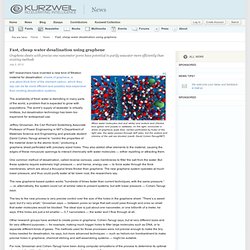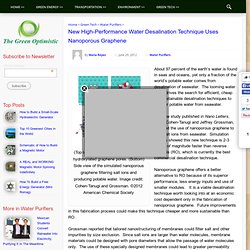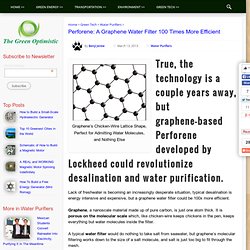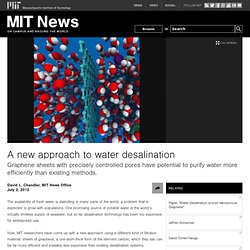

Desalination. Desalination involves removing the salt from water to make it drinkable.

There are several ways to do it, and it is not a new idea at all. Sailors have been using solar evaporation to separate salt from sea water for at least several thousand years. Most of the world’s 1,500 or so desalination plants use distillation as the process, and there are also flash evaporation and electrodialysis methods. All these methods are very expensive, so historically desalination has only been used where other alternatives are also very expensive, such as desert cities. However, an exploding world demand for potable water has led to a lot of research and development in this field and a new, cheaper process has been developed that involves heating sea water and forcing it through membranes to remove the salt from the water.
Also in 2006, the San Antonio Water System began tests at several sites to evaluate the feasibility of constructing a plant to desalinate brackish water from the Wilcox Aquifer. Links for DeSalination. Fast, cheap water desalination using graphene. When water molecules (red and white) and sodium and chlorine ions (green and purple) in saltwater, on the right, encounter a sheet of graphene (pale blue, center) perforated by holes of the right size, the water passes through (left side), but the sodium and chlorine of the salt are blocked (credit: David Cohen-Tanugi/MIT) MIT researchers have invented a new kind of filtration material for desalination: sheets of graphene, a one-atom-thick form of the element carbon, which they say can be far more efficient and possibly less expensive than existing desalination systems.

The availability of fresh water is dwindling in many parts of the world, a problem that is expected to grow with populations. The world’s supply of seawater is virtually limitless, but desalination technology has been too expensive for widespread use. One common method of desalination, called reverse osmosis, uses membranes to filter the salt from the water. The work was funded by the MIT Energy Initiative and a John S. New High-Performance Water Desalination Technique Uses Nanoporous Graphene. (Top left) Hydrogenated and (top right) hydroxylated graphene pores.

(Bottom) Side view of the simulated nanoporous graphene filtering salt ions and producing potable water. Image credit: Cohen-Tanugi and Grossman. ©2012 American Chemical Society About 97 percent of the earth’s water is found in seas and oceans, yet only a fraction of the world’s potable water comes from desalination of seawater. The looming water crisis drives the search for efficient, cheap and sustainable desalination techniques to recover potable water from seawater.
In a new study published in Nano Letters, David Cohen-Tanugi and Jeffrey Grossman, reported the use of nanoporous graphene to filter salt ions from seawater. Nanoporous graphene offers a better alternative to RO because of its superior performance, less energy inputs and use of smaller modules. Grossman reported that tailored nanostructuring of membranes could filter salt and other impurities by size exclusion.
[source: phys.org] Water Purifiers Archives » The Green Optimistic. Ultrasand - water desalination and purification using graphene coated sand. Perforene: A Graphene Water Filter 100 Times More Efficient. Graphene’s Chicken-Wire Lattice Shape, Perfect for Admitting Water Molecules, and Nothing Else Lack of freshwater is becoming an increasingly desperate situation, typical desalination is energy intensive and expensive, but a graphene water filter could be 100x more efficient.

Graphene, a nanoscale material made up of pure carbon, is just one atom thick. Making Salt Water Drinkable Just Got 99 Percent Easier. A new approach to water desalination. The availability of fresh water is dwindling in many parts of the world, a problem that is expected to grow with populations.

One promising source of potable water is the world’s virtually limitless supply of seawater, but so far desalination technology has been too expensive for widespread use. Now, MIT researchers have come up with a new approach using a different kind of filtration material: sheets of graphene, a one-atom-thick form of the element carbon, which they say can be far more efficient and possibly less expensive than existing desalination systems.
When water molecules (red and white) and sodium and chlorine ions (green and purple) in saltwater, on the right, encounter a sheet of graphene (pale blue, center) perforated by holes of the right size, the water passes through (left side), but the sodium and chlorine of the salt are blocked.Graphic: David Cohen-Tanugi.